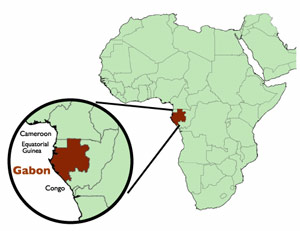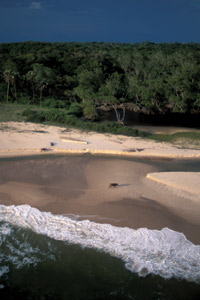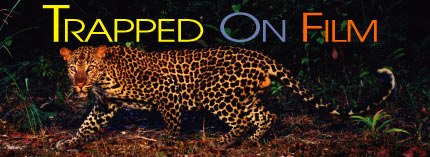 |
article
by Jessica Gordon downloadable
.pdf
AN
HOUR AFTER SUNSET ON HIS LAST NIGHT IN THE WEST AFRICAN COUNTRY
OF GABON, UF GRADUATE STUDENT CARLTON WARD JR. MADE SOME FINAL
SHOTS OF A NATIVE HOPPOPOTAMUS BATHING IN A FRESHWATER LAGOON
AND BEGAN PACKING HIS CAMERA GEAR.
WARD
HAD SEEN HIPPO TRACK LEADING TO THE OCEAN IN THE AREA KONWN
AS GAMBA OFTEN AND KNEW HIPPOS OCCASIONALLY SWAM IN THE SALTY
ATLANTIC OCEAN, BUT DURING HIS 10-WEEK STAY HE HAD YET TO
WITNESS THE RARE SIGHT
| |
| Hippo
in the Surf
A male hippo (Hippopotamus amphibius) lurks in the Atlantic
waves. The Gamba coastline is the only place this behavior
has been observed. |
Suddenly,
the 8,000-pound hippo began lumbering across the sand toward
the ocean 150 yards ahead of Ward. He instinctively grabbed
his Nikon camera and a 200-millimeter lens and raced toward
the animal as it made its way into the surf. As dusk turned
to night, Ward waded into the black water and, with the waves
churning around his waist, brought the camera to his eye just
as the hippo stopped on a sandbar and turned around.
The
flash was just enough to silhouette the hippo’s massive
bulk and illuminate its piercing yellow eyes. For Ward, the
picture captures Gamba perfectly — an African hippo
transcending its traditional environment. It’s that
image and others like it in a book of his photographs due
out at the end of 2003 that Ward hopes will convey to an international
audience the importance of preserving Gabon’s unique
environment.
An
eighth-generation Floridian, 27-year-old Ward has always had
an interest in the ecology and history of Florida. While earning
his bachelor’s degree at Wake Forest University, he
studied biology and anthropology. He got his first camera
when he went to study abroad in Australia.
“From
that time, I’ve been pretty much obsessed with photography,”
he says. “But I started turning toward environmental
subjects because that’s what my background and training
was in.”
After
graduation, Ward interned in the photography department at
the Smithsonian National Museum of Natural History and then
honed his skills for two years in Florida and travelled to
places like the Peruvian Amazon and the Andes Mountains. In
fall 2000, he returned to school. He chose UF’s Natural
Sciences Department because of the strength of its master’s
program and his lifelong interest in Florida ecology. The
program allowed Ward to do his course work and training in
science but his thesis through another college. Ward chose
the College of Journalism and Communications, where he became
the first UF graduate student to combine his environmental
studies with photojournalism.
“There
obviously is a subfield of environmental journalism,”
says Stephen Humphrey, director of the School of Natural Resources
and Environment. “Carlton’s photography is based
on ecology at its intellectual core. This sort of journalism
requires a very good understanding of ecology experimentation
and practice. His journalistic view is grounded in the scientific
field that he works with.”
Although
his passion for the environment was always present, a way
to present his pictures as stories didn’t always come
naturally.
|
| Buffalo
on the Beach
Taking advantage of a morning low tide, forest buffalo
(Syncerus caffer) walk north along the beach in
one of the only places remaining in Africa where
large mammals can move along the coast free of human
disturbance. |
|
Nowhere
else in Africa does intact tropical rain forest still
come right down to the ocean like it does in Gabon |
“The
technical side of photography came fairly easily — I
have a fairly scientific mind,” Ward says. “But
when I started my work at the University of Florida, I had
a portfolio with a lot of pretty pictures but not so much
journalism. And that’s what I was trying to learn and
I’m still trying to learn — incorporating a story-telling
journalistic approach with photography.”
Ward’s
graduate adviser and committee chair, journalism Assistant
Professor John Kaplan, helped Ward evolve from nature photographer
to photojournalist.
“When
I first met Carlton, he had a strong grasp of science and
the technical issues of photography, but what he was lacking
was a way to connect that with telling stories and connecting
with people. I think he has really worked to find that balance
of bringing those elements together and being an effective
photographer,” Kaplan says.
In
the summer of 2001, Ward’s Smithsonian internship paid
off with an opportunity to document the work of a team of
Smithsonian scientists doing research in Gabon.
“We
wanted to have a photographer full time in order to create
the first database for this region and to have high-quality
material to publish very quickly,” says Francisco Dallmeier,
director of the Smithsonian Institution Monitoring and Assessment
of Biodiversity Program (SI/MAB). “Carlton is very energetic
and flexible, and he makes it happen. He was very valuable
to our team.”
Ward
decided to turn the Gamba project into his thesis.
Glorious
Gabon
Nowhere
else in Africa does intact tropical rain forest still come
right down to the ocean like it does in Gabon, a country of
a little more than one million people that still has 90 percent
of its tropical rain forest intact.

Bordering the Atlantic Ocean at the Equator, Gabon is sandwiched
between the far-more-developed countries of the Cameroon and
Congo. Once a French colony, Gabon gained independence in
1960 and now governs as a republic. Oil and mineral reserves
have made Gabon fairly wealthy and allowed for the conservation
of biodiversity because its economy did not have to rely heavily
on logging. As oil reserves begin to decline, concerns about
deforestation and poaching are very real.
“You
get this astonishing, rich diversity of plants and animals
that live in the Congo Forest coming right down to a tropical
beach like you would see in Florida and the Caribbean,”
Ward says. “The combination of African animals with
a tropical coastal landscape, elephants that go on the sand,
hippos that go in the surf, chimpanzees and gorillas that
are in the forest close by — there’s nowhere in
the world like that because every other country in equatorial
Africa now has heavy coastal development. Gamba, within Gabon,
is part of the most continuous expansive undeveloped coastline
and rain forest left for Africa.”
Gamba
is a town in southwest Gabon surrounded by an environmental
district called the Gamba Complex that is comprised of coastline,
grasslands, lagoons, rivers, wetlands, mountains and tropical
rain forest. The Gamba Project was developed in 1999 by SI/MAB
with funding from the Shell Foundation’s Sustainable
Energy Programme and Shell Gabon to assess and monitor the
biodiversity in the Gamba Complex.
“I’ve
been to Gabon six times since that first time in July 2001,
and it has evolved from a partially, paid internship to a
full contract position with them,” Ward says. “I’ve
worked with them to see the value of using imagery to communicate
their research to the scientific community as well as the
popular audience.”
 Ward’s
photographic mission in Gabon was to raise awareness both
domestically and internationally about the biodiversity of
the country’s natural environment. Ward’s
photographic mission in Gabon was to raise awareness both
domestically and internationally about the biodiversity of
the country’s natural environment.
While
much of his time was spent documenting the plants and animals
the
scientists brought to him, Ward also sought out his own subjects,
capturing large animals in their natural environment —
a family of elephants skirting the lush green jungle, wild
buffalo strolling along the beach against a hazy blue fog
and a startled leopard, frozen in its tracks (this one taken
using a sophisticated camera trap).
“Carlton
has a rare combination of intellect, scientific inquiry and
ethic vision,” Kaplan says. “He has a good sense
of color, and his pictures really come alive. He’s got
a wonderful eye, and I think his potential is limitless.”
Ward’s
work, much of which involves new species never before photographed
alive, has already affected Gabon’s citizens.
“I
would give slide presentations locally to the oil workers
and different people, and they were always impressed by the
diversity of life in these forests,” Ward says. “I
want to help people understand Gabon through popular magazines,
but equally important is to raise awareness within Gabon and
inspire them to want to protect their resources.”
Dallmeier
would like to see more of Ward’s type of photojournalism
in the environmental world.
“There
are so many hidden stories,” the scientist says. “By
the time they get to the people, sometimes it’s too
late. A physical description is a powerful tool in order to
influence decisions.”
Later
this year, The Smithsonian Institution expects to publish
a book-length photo essay about Gabon’s biodiversity,
titled The Edge of Africa. Ward helped coordinate the photography,
layout and design, and 90 percent of the content will be his
photographs accompanied by captions.
Ultimately,
Ward wants to continue the path of raising awareness about
environmental issues through photography and possibly explore
a doctoral program that suits his goals.
“I
love this idea of taking a project and trying to become an
expert in the area and making a book out of it,” he
says. “Gabon is a place where I’m able to make
a difference because I’m doing a lot of things for the
first time there, and there are not so many places left where
you can do that. I imagine I’ll continue to go back
to Gabon over my lifetime, but only when I find a story that
needs to be told.”

Carlton
Ward Jr. knew that to get the kinds of photographs he
wanted of Gabon’s illusive animals in their natural
environment he was going to have to be innovative.
So
he turned to his old friend, UF engineering student
Christopher Slaughter, to help him design the camera
trap and lighting he needed.
A
camera trap is an automatic system that triggers the
camera when an animal breaks a beam of infrared light
cast across a trail. Although the technique is commonly
used by hunters and scientists to monitor animal movement,
Ward needed a much higher-quality system to get the
kinds of photographs he wanted.
So
he and Slaughter built their own. They constructed waterproof
plastic enclosures for the cameras and modified industrial-sized
flashlight housings for the flash units.
The
greatest challenge, especially in such a wet environment,
was wiring the flashes so they would stay charged and
ready for up to two weeks. Although the Nikon system
he was using had a good standby mode that let the flash
sleep until the camera was activated, it worked only
with one flash. Most of Ward’s images required
two or three flashes, so he and Slaughter had to redesign
all the wiring.
 |
| FROM
LEFT TO RIGHT:
WHITE BELLIED KINGFISHER, Alcedo
leucogaster, ANGOLA FRUIT BAT,
Lissonycteris angolensis, COMMON TREE FROG,
Leptopelis notatus, RED CHESTED OWLET,
Glaucidium tephronotum |
“Nikon
gave us a wiring schematic of what National Geographic
uses,” Slaughter says. “It headed us in
the right direction, but there was a lot of trial and
error. The benefit of ours is that it’s modular
— it can be used with one flash or three.”
Although
he worked to find trails that looked like they had a
lot of activity, and estimated the best angles for shots,
the system was not foolproof. Many times, he’d
get only two or three pictures.
“There’s
no way to know if you’re going to get half of
an animal or whether the animal’s going to be
looking the other way,” he says.
However
little activity, the results paid off. One photograph,
of a leopard in its natural habitat looking straight
into the lens, exemplifies Ward’s efforts.
“I
could spend 10 years in the rain forest and never have
the chance to photograph a leopard that close with a
camera in my hand. It’s a very journalistic approach
because you’re photographing an animal without
human interference,” he says.
For
small animals, including birds, reptiles and insects,
Ward designed and built portable studios he could use
in the field.
For
insects, he used a “modular macro studio,”
with high-quality lighting and a macro lens to capture
insects in smooth detail.
For
birds and bats, Ward built a 10-foot by 4-foot portable
studio out of white nylon sailcloth and black velvet.
He used a lot of patience and some verbal encouragement
to get birds to perch on a branch he placed in the enclosure
while he photographed them.
“Part
of my goal was to document the different species for
biodiversity study because a lot of these species have
not been photographed alive,” Ward says. “But
beyond just documenting, I tried to take it a step further
and create pictures that will captivate a reader and
get the essence of the subject.” |
|


